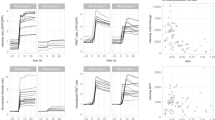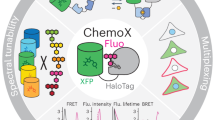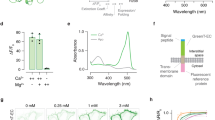Abstract
Genetically encoded Ca2+ indicators allow researchers to quantitatively measure Ca2+ dynamics in a variety of experimental systems. This protocol summarizes the indicators that are available, and highlights those that are most appropriate for a number of experimental conditions, such as measuring Ca2+ in specific organelles and localizations in mammalian tissue-culture cells. The protocol itself focuses on the use of a cameleon, which is a fluorescence resonance-energy transfer (FRET)-based indicator comprising two fluorescent proteins and two Ca2+-responsive elements (a variant of calmodulin (CaM) and a CaM-binding peptide). This protocol details how to set up and conduct a Ca2+-imaging experiment, accomplish offline data processing (such as background correction) and convert the observed FRET ratio changes to Ca2+ concentrations. Additionally, we highlight some of the challenges in observing organellar Ca2+ and the alternative strategies researchers can employ for effectively calibrating the genetically encoded Ca2+ indicators in these locations. Setting up and conducting an initial calibration of the microscope system is estimated to take ∼1 week, assuming that all the component parts are readily available. Cell culture and transfection is estimated to take ∼3 d (from the time of plating cells on imaging dishes). An experiment and calibration will probably take a few hours. Finally, the offline data workup can take ∼1 d depending on the extent of analysis.
This is a preview of subscription content, access via your institution
Access options
Subscribe to this journal
Receive 12 print issues and online access
$259.00 per year
only $21.58 per issue
Buy this article
- Purchase on Springer Link
- Instant access to full article PDF
Prices may be subject to local taxes which are calculated during checkout


Similar content being viewed by others
References
Rizzuto, R., Brini, M. & Pozzan, T. Targeting recombinant aequorin to specific intracellular organelles. Methods Cell Biol. 40, 339–358 (1994).
Robert, V., Pinton, P., Tosello, V., Rizzuto, R. & Pozzan, T. Recombinant aequorin as tool for monitoring calcium concentration in subcellular compartments. Methods Enzymol. 327, 440–456 (2000).
Miyawaki, A. et al. Fluorescent indicators for Ca2+ based on green fluorescent proteins and calmodulin. Nature 388, 882–887 (1997).
Romoser, V.A., Hinkle, P.M. & Persechini, A. Detection in living cells of Ca2+-dependent changes in the fluorescence emission of an indicator composed of two green fluorescent protein variants linked by a calmodulin-binding sequence. J. Biol. Chem. 272, 13270–13274 (1997).
Miyawaki, A., Griesbeck, O., Heim, R. & Tsien, R.Y. Dynamic and quantitative Ca2+ measurements using improved cameleons. Proc. Natl. Acad. Sci. USA 96, 2135–2140 (1999).
Truong, K. et al. FRET-based in vivo Ca2+ imaging by a new calmodulin-GFP type molecule. Nat. Struct. Biol. 8, 1069–1073 (2001).
Heim, N. & Griesbeck, O. Genetically encoded indicators of cellular calcium dynamics based on troponin C and green fluorescent protein. J. Biol. Chem. 279, 14280–14286 (2004).
Palmer, A.E., Jin, C., Reed, J.C. & Tsien, R.Y. Bcl-2-mediated alterations in endoplasmic reticulum Ca2+ analyzed with an improved genetically encoded fluorescent sensor. Proc. Natl. Acad. Sci. USA 101, 17404–17409 (2004).
Mank, M. et al. A FRET-based calcium biosensor with fast signal kinetics and high fluorescence change. Biophys. J. 90, 1790–1796 (2006).
Palmer, A.E. et al. Ca2+ indicators based on computationally-redesigned calmodulin–peptide pairs. Chem. Biol. 13, 521–530 (2006).
Ishii, K., Hirose, K. & Iino, M. Ca2+ shuttling between endoplasmic reticulum and mitochondria underlying Ca2+ oscillations. EMBO Rep. 7, 390–396 (2006).
Baird, G.S., Zacharias, D.A. & Tsien, R.Y. Circular permutation and receptor insertion within green fluorescent proteins. Proc. Natl. Acad. Sci. USA 96, 11241–11246 (1999).
Griesbeck, O., Baird, G.S., Campbell, R.E., Zacharias, D.A. & Tsien, R.Y. Reducing the environmental sensitivity of yellow fluorescent protein. J. Biol. Chem. 276, 29188–29194 (2001).
Nakai, J., Ohkura, M. & Imoto, K. A high signal-to-noise Ca2+ probe composed of a single green fluorescent protein. Nat. Biotech. 19, 137–141 (2001).
Ohkura, M., Matsuzaki, M., Kasai, H., Imoto, K. & Nakai, J. Genetically encoded bright Ca2+ probe applicable for dynamic Ca2+ imaging of dendritic spines. Anal. Chem. 77, 5861–5869 (2005).
Nagai, T., Sawano, A., Park, E.S. & Miyawaki, A. Circularly permuted green fluorescent proteins engineered to sense Ca2+. Proc. Natl. Acad. Sci. USA 98, 3197–3202 (2001).
Filippin, L., Magalhaes, P.J., Benedetto, G.D., Colella, M. & Pozzan, T. Stable interactions between mitochondria and endoplasmic reticulum allow rapid accumulation of calcium in a subpopulation of mitochondria. J. Biol. Chem. 278, 39224–39234 (2003).
Filippin, L. et al. Improved strategies for the delivery of GFP-based Ca2+ sensors into the mitochondrial matrix. Cell Calcium 37, 129–136 (2005).
Nagai, T., Yamada, S., Tominaga, T., Ichikawa, M. & Miyawaki, A. Expanded dynamic range of fluorescent indicators for Ca2+ by circularly permuted yellow fluorescent proteins. Proc. Natl. Acad. Sci. USA 101, 10554–10559 (2004).
Iwano, M. et al. Ca2+ dynamics in a pollen grain and papilla cell during pollination of Arabidopsis. Plant Physiol. 136, 3562–3571 (2004).
Kerr, R. et al. Optical imaging of calcium in neurons and pharyngeal muscle of C. elegans. Neuron 26, 583–594 (2000).
Reiff, D.F., Thiel, P.R. & Schuster, C.M. Differential regulation of active zone density during long-term strengthening of Drosophila neuromuscular junctions. J. Neurosci. 22, 9399–9409 (2002).
Fiala, A. et al. Genetically expressed cameleon in Drosophila melanogaster is used to visualize olfactory information in projection neurons. Curr. Biol. 12, 1877–1884 (2002).
Reiff, D.F. et al. In vivo performance of genetically encoded indicators of neural activity in flies. J. Neurosci. 25, 4766–4778 (2005).
Higashijima, S., Masino, M.A., Mandel, G. & Fetcho, J.R. Imaging neuronal activity during zebrafish behavior with a genetically encoded calcium indicator. J. Neurophysiology 90, 3986–3997 (2003).
Hasan, M.T. et al. Functional fluorescent Ca2+ indicator proteins in transgenic mice under TET control. PLoS Biol. 2, 763–775 (2004).
Ji, G. et al. Ca2+-sensing transgenic mice: postsynaptic signaling in smooth muscle. J. Biol. Chem. 279, 21461–21468 (2004).
Shaner, N.C., Steinbach, P.A. & Tsien, R.Y. A guide to choosing fluorescent proteins. Nat. Methods 2, 905–909 (2005).
Gordon, G.W., Berry, G., Liang, X.H., Levine, B. & Herman, B. Quantitative fluorescence resonance energy transfer measurements using fluorescence microscopy. Biophys. J. 74, 2702–2713 (1998).
Zal, T. & Gascoigne, N.R. Photobleaching-corrected FRET efficiency imaging of live cells. Biophys. J. 86, 3923–3939 (2004).
Miyawaki, A. & Tsien, R.Y. Monitoring protein conformations and interactions by fluorescence resonance energy transfer between mutants of green fluorescent protein. Methods Enzymol. 327, 472–436 (2000).
Sambrook, J. & Russel, D.W. Molecular Cloning: A Laboratory Manual (Cold Spring Harbor Laboratory Press, New York, 2001).
Adams, S.R., Bacskai, B.J., Taylor, S.S. & Tsien, R.Y. in Fluorescent Probes for Biological Activity of Living Cells — A Practical Guide (eds. Matson, W.T. & Relf, G.) 133–149 (Academic Press, New York, 1993).
Acknowledgements
We would like to thank J. Evans for helpful advice on this manuscript. This work was supported by the following grants: Ruth L. Kirschstein NIH postdoctoral fellowship F32 GM067488-01 to A.E.P., NIH NS27177 to R.Y.T. and funds from the University of Colorado to A.E.P.
Author information
Authors and Affiliations
Corresponding author
Ethics declarations
Competing interests
The authors declare no competing financial interests.
Rights and permissions
About this article
Cite this article
Palmer, A., Tsien, R. Measuring calcium signaling using genetically targetable fluorescent indicators. Nat Protoc 1, 1057–1065 (2006). https://doi.org/10.1038/nprot.2006.172
Published:
Issue Date:
DOI: https://doi.org/10.1038/nprot.2006.172
This article is cited by
-
Absolute measurement of cellular activities using photochromic single-fluorophore biosensors and intermittent quantification
Nature Communications (2022)
-
Ubiquitin-specific protease 3 facilitates cell proliferation by deubiquitinating pyruvate kinase L/R in gallbladder cancer
Laboratory Investigation (2022)
-
Distinct calcium regulation of TRPM7 mechanosensitive channels at plasma membrane microdomains visualized by FRET-based single cell imaging
Scientific Reports (2021)
-
Ttm50 facilitates calpain activation by anchoring it to calcium stores and increasing its sensitivity to calcium
Cell Research (2021)
-
SMARCA4/2 loss inhibits chemotherapy-induced apoptosis by restricting IP3R3-mediated Ca2+ flux to mitochondria
Nature Communications (2021)
Comments
By submitting a comment you agree to abide by our Terms and Community Guidelines. If you find something abusive or that does not comply with our terms or guidelines please flag it as inappropriate.



